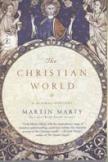Two Billion Strong
Martin Marty’s new book appears in a series called “Modern Library Chronicles,” which includes similarly concise volumes on such complex subjects as the Renaissance, Shakespeare and the Catholic Church, by authors as redoubtable as Paul Johnson, Frank Kermode and Hans Küng. Treating a topic as large as global Christianity within a single slender volume requires an extraordinary grasp of the subject, an efficient style and a gift for organization. Marty here demonstrates once more that he remains in firm possession of all three.
The global vision is especially instructive for those who are unfamiliar with either Christianity’s most distant past or most hopeful present. Marty sets out to displace the Euro-American focus that is instinctive to many of his readers. He naturally starts with “Jewish beginnings,” using Jesus and Paul to establish both Christianity’s first convictions and its first cultural engagements. But then, rather than make the usual turn to Rome and Europe that is found first in the Acts of the Apostles, he invites the reader to consider the areas in which Christianity exercised its first great influence, in the “First Asian Episode” and in the “First African Episode.” Although the material dealt with in these chapters is fairly standard, Marty invites readers to consider how Christianity not only quickly reached such distant lands as Persia, Georgia and Armenia (in Asia) as well as Algeria and Ethiopia (in Africa), but flourished for centuries, producing some of Christianity’s greatest leaders and thinkers before finally succumbing (in part or entirely) to Islam.
Readers with some knowledge of history will recognize much of the material covered—very effectively—in the first and second “European Episodes,” which cover in turn medieval Christianity and the varieties of reformation. In these chapters, Marty displays his distinctive ability to make accurate generalizations that are supported by many sharp details. One is startled in a treatment so broad to learn about Abelard and Heloise’s romance as well as Bernard of Clairvaux’s less than attractive side, to hear of Hildegard of Bingen’s teaching ministry as well as her visions. Similarly, it is good to hear as much about Anabaptist and Anglo-Catholic versions of reform as of Lutheran and Calvinist. Along the way, Marty not only provides thumbnail sketches of what he calls “capital letter” topics such as Renaissance, Reformation, Enlighten-ment and Industrial Revolution, together with their impact on Christianity, but he also shows how a combination of these cultural forces and a deeply divided Christianity provided a springboard for the mission endeavors of European Christianity.
As in his other chapters, Marty’s treatment in the “Latin American Episode” traces a historical development in that part of the world—in this case, all the way from the first Catholic conquerors/ colonists/missionaries from Portugal and Spain down to the most recent developments of Liberation Theology and the success of evangelical and Pentecostal Christianity in the late 20th century. His depiction never flinches from the ugliness and cruelty that characterized Christian behavior toward indigenous peoples; at the same time he finds whatever small redeeming touches of humanity he can among those seeking to save the “savages” even as they destroyed them. And as we would expect from an eminent historian of American religion, Marty’s discussion in the “North American Episode” is both incisive and remarkably inclusive (giving proportionate attention to Canada as well as the United States, to Catholicism as well as Protestantism).
The impact of Marty’s organizational scheme is greatest when he turns to the “Second African Episode” and the “Second Asian Episode.” With North Africa sealed off by Islam, Christian missionaries struggled to establish missions in the rest of the great continent, their efforts compromised, as in other areas, by being intermixed with commerce and politics as well as by a refusal to understand or appreciate local cultures. But despite such uncertain beginnings, churches finally achieved a genuinely African growth and character. In Asia also, the early successes of Francis Xavier and companions were followed by the persecution of tiny Christian communities and a closure to further missionary work. Yet today places like South Korea and the Philippines are among the most thriving examples of Christian faith—even if the Christians of South Korea face the atheistic regime to the North, and Philippine Christians face the challenge of an equally successful Islam.
By considering in the final sections the partial success and promising if perilous future in the continents where Christianity first thrived, Marty effectively communicates the truly global character of this faith, for which the success or failure of the European and American “episodes” do not in themselves determine either its essence or its destiny. Among the many pleasures of Marty’s survey is the way in which he keeps in view Christianity’s relationship with Judaism and, of particular significance today, with Islam. When he poses the question of what the future global map of religion might have been after 1492 if Muslims rather than the Catholic Queen Isabella had sponsored trips to the new world, he shocks the reader into a recognition of how Islam in the past and in the present has challenged Christianity for global religious primacy.
The value of this small book goes well beyond its scope of vision and depth of detail. Marty enables his readers to ponder the knotty questions that lie beneath the smooth surface. Given its many cultural realizations and adaptations, what are the essential features of this religion and what accidental? Given the many ways in which its representatives have failed to live according to its ideals, how do we locate the appeal of this religion that enables it, even today, to command the adherence of some two billion of the world’s people? Readers from the least to the most learned can profit from this master scholar’s history of the Christian world.
This article also appeared in print, under the headline “Two Billion Strong,” in the September 15, 2008, issue.








